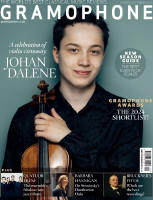Texte paru dans: / Appeared in:
Hyperion
CDA68448
|
|
 |
|
|
Echoes of childhood piano lessons have probably made the two-part Inventions and three-part Sinfonias among the least sexy areas of Bach’s keyboard output, at least as far as recording is concerned. Bach designed them as teaching material for his sons and other students, so in a sense they are more for playing than for listening to, but a complete cycle must include them somewhere. On the sixth release of his series, Mahan Esfahani has perhaps been wise in choosing to get them done relatively early to draw in the completists while the iron is hot, but in doing so he proves more than adequately that in their way they can be just as much of a delight for the ear as the grander suites, preludes, fugues and variations. He also includes 22 tiny Preludes gathered from a handful of manuscript sources including the ClavierBüchlein Sebastian prepared for his nineyear-old son Wilhelm Friedemann, and short though they may be – none lasts longer than two minutes – their personality, invention and keyboard resource are full-on Bach, pure and lovable.
If anything, it is the preludes that emerge with the greatest freshness as cameos of differing Bach keyboard styles, as if he were improvising them for us as private demonstrations, any of which could easily extend into something bigger. By no means always simple or easy, some are like exercises, others like concerto ritornellos, fast-living toccatas or melancholy fantasias whose dreaminess surely influenced the mature music of his sons. The seven ‘Friedemann’ preludes sound especially effective as rendered on the clavichord by Esfahani, his intimate fluctuations of dynamic and tempo drawn out with beguiling freedom and sensitivity of characterisation – one ends heart-rendingly with the final note almost inaudible, like a gasp. The same strength of inspiration is evident in the similarly miniaturised Inventions, and they are no less skilfully rendered on the clavichord, so it is perhaps only a trick of their greater familiarity that makes them seem less of a revelation (though I doubt if the F major Invention can ever have sounded so sunny or sprightly).
For the Sinfonias (and six of the Preludes) Esfahani uses his own harpsichord, its unusual carbon-fibre soundboard giving these slightly more ambitious compositions imposing clarity, resonance and a more public projection, if perhaps at the cost of tonal sweetness and personality. As in the other pieces, Esfahani considers each of these little jewels on its own merits, and by the time we have journeyed through almost-fugues and the twisting chromaticism of the F minor, the 16-foot stop is out for the 15th and last Sinfonia, all unworthy thoughts of smallness now firmly banished. |
|



